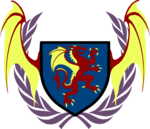Vrigny (Pacifica): Difference between revisions
m (→Demographics) |
m (Density map) |
||
| Line 150: | Line 150: | ||
== Demographics == | == Demographics == | ||
[[File:Vrigny Population Density (Pacifica).png|thumb|350x350px|Population density of all Vrignyan municipalities.]] | |||
Vrigny has a relatively numerous population of 51,237,971 as of December 2022's census. Despite the country's relative population density of 283/km<sup>2</sup> (733.0/sq mi), the absolute majority of Vrignyans live in the country's 15 cities, having Vrigny an urban population percentage of 97.4%. The yearly population growth is around 0.4 to 0.7%, mainly due to natural growth. The average life expectancy at birth in Vrigny is 82.3 years, which has greatly increased in the last 10 years since the fall of the Stratocracy. | Vrigny has a relatively numerous population of 51,237,971 as of December 2022's census. Despite the country's relative population density of 283/km<sup>2</sup> (733.0/sq mi), the absolute majority of Vrignyans live in the country's 15 cities, having Vrigny an urban population percentage of 97.4%. The yearly population growth is around 0.4 to 0.7%, mainly due to natural growth. The average life expectancy at birth in Vrigny is 82.3 years, which has greatly increased in the last 10 years since the fall of the Stratocracy. | ||
Revision as of 13:17, 1 June 2024
Fourth Republic of Vrigny Verten Rexpublik Vrigny | |
|---|---|
Motto: Bar ev dett, Rexpublik! Rise and fall, Republic! | |
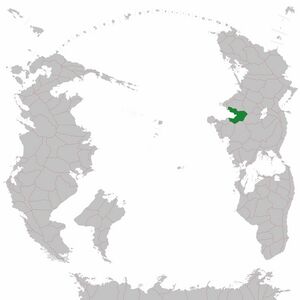 | |
| Capital and largest city | Adleimen |
| Official languages | Vrignyan
|
| Religion (2024) | 98.8% non-religious
1% Zarkanxiz 0.2% Other |
| Demonym(s) | Vrignyan |
| Government | Democratic unitary presidential republic |
• President | Anneliese Bow |
• Vicepresident | Leonard Hustigs |
| Legislature | Parliament |
| History | |
• Established | ~4000 BCE |
• First Zarnarchy | ~3400 BCE |
• Vrignyan Revolution | 1801-1812 |
• Vrignyan Civil War | 1903-1908 |
• First Stratocracy | 1921-1932 |
• Third Republic | 1932-1953 |
• Second Stratocracy | 1953-2014 |
• Fourth Vrignyan Republic | 2014-Current |
| Area | |
• Total | 181,276 km2 (69,991 sq mi) |
| Population | |
• 2022 census | 51,237,971 |
• Density | 283/km2 (733.0/sq mi) |
| GDP (PPP) | 2022 estimate |
• Total | $2.386 trillion |
• Per capita | $46,562 |
| GDP (nominal) | 2022 estimate |
• Total | $1.601 trillion |
• Per capita | $31,245 |
| Gini (2022) | low |
| HDI (2023) | very high |
| Currency | Cernic (CRN) |
| Time zone | UTC+2 |
| Date format | dd/mm/yyyy CE |
| Driving side | right |
| Internet TLD | .vy |
Vrigny, oficially the Fourth Republic of Vrigny (Vrignyan: Verten Rexpublik Vrigny) is a medium-sized independent country located in western-central Bailtem. It is bordered by Brodlancia on the southwest, the South Pacific Ocean on the west, Detroxia as well as Sallodesia on the south and Numano on the east. The country is characterized by its tropical weather on the north, and its oceanic climate on the south. Due to this, most of the country's population, urban areas and farms are located on the south, as well as the east. However, due to a history of deforestation and relentless urban expansion, many of the tropical rainforests of the north have been long gone for ages, being replaced by cities, farms and expansive open-pit mines.
Vrigny is a unitary state, without any provinces. With a total area of 181,276 km2 (69,991 sq mi) and a population of 51,237,971, the country has an average population density of 282.65 people/km2 (732 people/sq mi). However, the majority of the population (>80%) lives in the three largest cities of Adleimen, Lifov and Vraks, which have a population of: 32,256,478; 7,215,036 and 3,456,202 respectively. Adleimen, as one of the largest cities in the whole of Pacifica, is the capital of Vrigny. With an area of around 7,200 km2 (sq mi), it is the result of the merging of the former cities of Adlan and Heimen, as a result of an extreme urbanization project led by the previous Dictatorship. This project was frowned upon by many, not because of the large amounts of rainforest cleared for the construction of the cities, but due to the forced resettlement of many rural Vrignyans, accustomed to a peaceful life in their small town, into a more industrialized city full of skyscrapers.
Since the birth of The Fourth Republic in 2014, due to the Constitution written by Samuel Romer and Victor Teryz, the country has been a democratic presidential and constitutional republic, however, until the elaboration of the current, "truly democratic" Constitution, elaborated by the SPV and LPV, Vrigny's democracy was a barely-functional two-party system, which required coalitions to be registered as political parties, and it led to several disagreements of the political sub-groups inside them. With the collapse of the Center Coalition, and later on the Worker's Union, now the independent SPV and LPV transformed Vrigny's democracy into a multiple-party system under proportional representation, and gave the country's only chamber, the Parliament, a total of 425 seats. Vrigny is currently ruled by President Anneliese Bow, from the Green Party of Vrigny (GPV) following its overwhelming victory in the March 24' Snap Elections.
Despite Vrigny's prolonged Dictatorship and isolationism, it mantains a relatively high human development index (HDI) and a decent economy for the size of its population. Vrigny has had an universal public healthcare system since the late Third Republic, and the Dictatorship expanded the public education system as well. The last 10 years of the Fourth Republic have seen a noticeable economic growth and further development of the public sector and services, however, it seems that the nation still remains relatively isolated and has much more potential. The country is a large producer of steel and other refined metals, automobiles, uranium, pharmaceuticals and electronic equipment.
With the country's recent incorporation into the World Forum, its newly established relations with countries all over Pacifica will bring the country's situation into a new era, in which Vrigny will participate with fellow democratic countries and uphold democracy and the Vrignyan view of liberalism all over the world, instead of continuing with its previous prolonged armed neutrality.
Etymology
Vrigny's current name arose after the rise of the Zarkanxiz faith and posterior establishment of the Zarnarchy, around 3400 BCE. It is a shortening of the phrase: Vag raks ig nyn, which is directly translated to: "Long teeth in (this) land". The reason for this phrase is that the Zarkanxiz religion had human sacrifices for the harvesting of blood and the search of an eternal life as its core tenets, leading those which were conquered by the Zarnarchy to name the area controlled by it to describe it by that phrase, and eventually naming it Vrigny as an alternative to Zarkanxiz.
History
Prehistory
Ancient City-States Era (4000 - 3400 BCE)
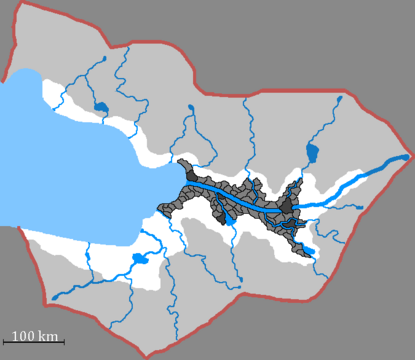
The Rise of Zarkanxiz (~3400 BCE)
The Zarkanxiz (Zarnarchy), also known in its early days as the Iregrilian Empire, is estimated to have been established in mid to late 3400 BCE. At this point in the history of the region which now encompasses central Vrigny, the city-state known back then as Iregril (nowaday's Vraks) developed writing, and soon enough, with it the organized religion of Zarkanxiz was founded. Old legends say that the Zarkanxiz faith came to be when the leader of a group of adventurers, Zarkan as well as his closest allies, were blessed trascendence by a Blood Dragon, with the power of giving immortality to those who deserve it in the world.
With the city being an absolute monarchy-of sorts, the king in power during the rise of the Zarkanxiz faith, Arelien, began a campaign to eradicate said religion, as it defied the city's yet older pantheon which was based in several "river deities". This religious purge was brutal. Iregril's army was one of the most powerful and developed out of all the Vengrilian city-states, if not the most powerful of them all. Many of the Zarkanxiz faithful either fled out of Iregril's walls to settle on the outside of the city, or fought against several talented Iregrilian spearmen, unsuccessfully. Lagor, which is considered to be the Zarkanxiz faith's prophet, organized a large group of followers (~10k), as well as Zarkanxiz Iregrilian soldiers (5k) and led the March of the Fifteen against King Arelien.
Unlike Arelien, Lagor was lowborn. This detail, as well as his charisma, and the spread of many Zarkaniums (Zarkanxiz's Scripture) made the takeover of the Zarkanxiz faith over Iregril inevitable. Despite Arelien's dwindling loyalist forces struggle, soon enough, the King was captured by Zarkanxiz warriors, and the remainder of his forces surrendered. Now, Iregril was under Zarkanxiz control, although it lacked a clear ruler. The Zarkanxiz clergy formed during the March, battle for Iregril and the aftermath, and was composed mostly by literate scribes and warriors. The first ever Raksier was then organized: King Arelien, some of his family members which did not convert and several of his loyal spearmen were sacrificed to Zarkan and the other deities by beheading with a large axe. King Arelien was executed by Lagor himself in order to prove his first victory to Zarkan. In the finalization of the ceremony, Lagor was crowned first ever Zarnarch of the Zarnarchy of Iregril in a ritual which bound Zarkan's control to his mind.
With the Zarkanxiz faith in total control of Iregril, the construction of a large pagan-like temple commenced in the center of Iregril, and the city-state began preparations to attack other nearby city-states to proselytize the Zarkanxiz faith and spread Zarkan's direct control to other regions near the Vengril.
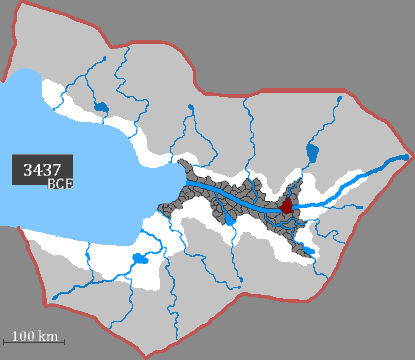
The Zarnarchy
Ancient Zarnarchy
Medieval Zarnarchy
(Insert Wars with Brodlancia and Montacia?)
Modern Zarnarchy
The Final Downfall
The Vrignyan Revolution
The First Republic
The Vrignyan Civil War
The Establishment of the SPV
The Second Republic
The First Stratocracy
Ferdinand Lawfen's Coup d'Etat
The MSO plot against Ferdinand Lawfen
The June Revolution
The Third Republic
Dominance of the SPV
The Second Stratocracy
The Generals Revolt
Ferdinand Lawfen's Death
The Fourth Republic
The Writing of the First Constitution
Geography
Climate
The North/South Discrepancy
Hydrology
The Vengril River
Flora
Fauna
Politics
The Fourth Republic of Vrigny is an unitary presidential republic. The current President is Anneliese Bow, and the Vicepresident is Leonard Hustigs. Vrignyan politics is based on the 2023 Constitution, which proclaims the country as a democratic republic, led by a Government elected directly by universal suffrage every four years.
Legislative power is reserved to the 425-member Vrignyan Parliament, in an unicameral system. Said Parliament has the power to legislate Government budget, constitutional amendments and modifications, as well as impeach the Government and call for new elections in extraordinary circumstances.
Government
The Vrignyan Government leads the executive branch and general administration in the Fourth Republic of Vrigny. The Vrignyan Constitution dictates that the Vrignyan Government has to objectively serve the general interests of Vrignyan citizens, and provide universal, public services to the Vrignyan population.
Currently, the Vrignyan Government is led by the Green Party of Vrigny. The Party's Leader, Anneliese Bow was voted President in the March 2024 Snap Elections after Lorena Ballons' resignation and collapse of the SPV-LPV-GPV Coalition Government which had been ruling since 2014.
The Vrignyan President is to direct the Vicepresident, and Ministers and can appoint and dismiss them freely. They are to respond politically to the Vrignyan Parliament for the action and goals of the Government. The impeachment of the President, or their resignation, implies the complete cessation of the Government, and elections will have to be held.
These are the current Ministers in the cabinet of President Lorena Ballons:
- Minister of Internal Security: Victor Zeraz.
- Minister of Economy: Glynn Lyon.
- Minister of Foreign Relations and Trade: Alexandra Shinser.
- Minister of Healthcare and Welfare: Linda Mina.
- Minister of Education and Research: Willem Friene.
- Minister of Industry: Vladim Margnian.
- Minister of Agriculture: Noah Thomas.
- Minister of Culture, Tourism and Sports: Diana Robert.
- Minister of Environment and Ecological Transition: Julius Cyren.
- Minister of Finance: Rosa Margarn.
- Minister of Justice: Roman Lilup.
- Minister of Infrastructure Development, Public Transport and Urbanization: Cristina Garchomp.
- Minister of Defense: Joseph Balein.
- Minister of Work and Social Affairs: Jacob Ferains
Political Parties
See also: List of political parties in Vrigny (Pacifica)
Vrigny is a multi-party democracy that uses a pure proportional representation system to elect 425 representatives in the Vrignyan Parliament. The system is completely centralized, meaning that all representatives represent the country as a whole, as there are no official provinces, or any kind of electoral system that divides the 425 representatives between different provinces or territories.
Vrigny also has an electoral threshold of 1%, meaning that parties that do not achieve 1% or more of the total vote will not get any representatives in the Vrignyan Parliament. Although Vrigny has many different political parties, those most relevant (that have ever achieved more than 1% of total votes) are the following:
- Major Parties: Green Party of Vrigny (GPV), Liberal Party of Vrigny (LPV) and the Socialist Party of Vrigny (SPV).
- Medium Parties: Industrial Syndicalist Party for Worker's Liberation (ISPfWL).
- Minor Parties: Exterior Vrigny Development Party (EVDP), Party For the Animals (PFtA), Conservative Party of Vrigny (CPV) and the Z-D Kresbo.
Foreign Relations
Military
See also: Vrignyan Armed Forces (Pacifica)
The Military Decay
After the end of the Second Vrignyan Stratocracy, the SPV-LPV-GPV Coalition Government led by President Lorena Ballons suddenly slashed the budget for the Vrignyan Armed Forces, which used to be constantly around 7-10% of the Vrignyan GDP, to just under 2% of the GDP. However, the great reduction of funding was not the only difficulty the Vrignyan Armed Forces had to face during the start of the Fourth Republic; military conscription was lifted by Samuel Romer in 2014, during the transition from the Stratocracy to the Republic. This led to a large diminishing of the manpower available to the Vrignyan Military; the army had number of around 2,180,000 personnel, combined for those part of the active and reserve forces. This number fell to around 230,000 a couple of years after the transition (which contributed to the Vrignyan 2014-2016 Unemployment Crisis) and has only continued to fall, due to the lack of confidence, resources and popularity of the Vrignyan Armed Forces among the population.
In the late Lorena Ballons' Government (November 2023), several Vrignyan officers attempted a coup d'Etat against the democratic Government, which saw no success. The officers and their small number of troops were easily stopped by the Vrignyan Internal Security Department (VISD), due to prior knowledge of their intentions. This led to the discharge and jailing of said Vrignyan officers, as well as some others which conspired or took part in the planning process. The main leaders of this coup d'Etat were also the last Vrignyan Citizens to be sentenced and dealt the Death Penalty in the country, before it was completely abolished from Vrignyan Military Justice in early 2024.
Economy
See also: List of Companies of Vrigny (Pacifica)
Demographics
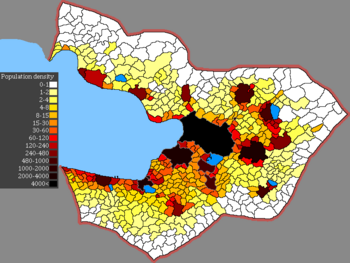
Vrigny has a relatively numerous population of 51,237,971 as of December 2022's census. Despite the country's relative population density of 283/km2 (733.0/sq mi), the absolute majority of Vrignyans live in the country's 15 cities, having Vrigny an urban population percentage of 97.4%. The yearly population growth is around 0.4 to 0.7%, mainly due to natural growth. The average life expectancy at birth in Vrigny is 82.3 years, which has greatly increased in the last 10 years since the fall of the Stratocracy.
Vrigny has experienced a very low amount of immigration since the 1950's due to the authoritarian Stratocracy. Despite the liberal integration laws and facility to obtain Vrignyan citizenship for foreign nationals, until now, Vrigny has not seen a high number of immigrants. Now, with liberal laws, a relaxed view on religion and comparatively affordable housing and free education, Vrigny is an attractive country for immigration.
Cities
See also: List of cities in Vrigny (Pacifica)
As mentioned before, 97.4% of the Vrignyan population lives in urban areas. Vrigny's largest city, Adleimen, accounts for around 63% of the country's total population just on its own, with a population of 32.2 million. The other Vrignyan cities with populations over 1 million are the following: Lifov (7.2 million), Vraks (3.5 million), Sylce (1.8 million) and Dianxe (1.1 million).
Language
Religion
See also: Zarkanxiz (Pacifica), Purple Article (Pacifica)
From Antiquity until the Vrignyan Revolution, in the first decade of the 19th Century, Vrigny was a theocratic elective monarchy under the Zarkanxiz religion, simply called "The Zarnarchy" (Vrignyan: Zarkanxiz). The Zarkanxiz religion

